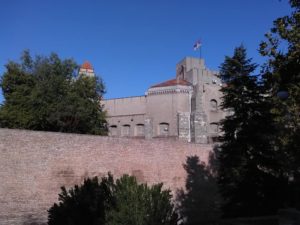The Yorkshire Dales is one of my favourite places to visit in the UK, and I almost always make time to get up there when I’m in the UK, no matter whether I’m there for work, conferences or just to travel.
Skipton Castle – A good day trip from Leeds
This time I was in Leeds for a weekend, using up a credit with Opera North, which was about to expire. After seeing a fantastic performance of My Fair Lady, on Saturday my Sunday was totally free and I decided to head out to Skipton. Skipton is a charming market town on the southern edge of the Yorkshire Dales and easily accessible as a day trip by train from Leeds. I particularly wanted to see the Castle, which is one of the best-preserved medieval castles in England. I have been before, about 15 years ago, but since I also needed to do some writing research in Skipton, it was an excellent opportunity to kill two birds with one stone.

Getting to Skipton Castle
There are several ways to get to Skipton. It’s on Leeds to Carlisle train line and is about 40 minutes from Leeds and about 90 minutes from Carlisle. If you’re coming from Carlisle, you’ll pass over the Ribbledale Viaduct. This viaduct is often mistaken for the viaduct on the train journey to Hogwarts used in the Harry Potter films. You’ll also pass through the lovely town of Settle, which is well worth a visit, especially for walkers.

Alternatively, there are Skipton bound buses from other parts of the Dales. In the past, I’ve caught one from the Dales village of Kettlewell (another good place for walkers), which passes through Grassington. Whether you go by bus or train, there are plenty of signs pointing to the Castle and the Woods attached to the Castle. In such a small town it would be hard not to find it! If you drive there, you’ll find plenty of parking right next to the castle.
Skipton – The Gateway to the Yorkshire Dales
Skipton itself is a charming market town with a rich history and a lively community. The town’s market, held four days a week, is one of the oldest in England. It offers a variety of local produce, crafts, and antiques. There are canal boat rides (some for as little as £5 at the time of writing) along the Leeds and Liverpool Canal, which runs through the town. A walk along the towpath offers beautiful views of the canal boats. For those interested in history, the Craven Museum & Gallery, in the town hall, provides an in-depth look at the local history and culture.
Skipton Castle
The Castle was built around 1090 by Robert de Romille, a Norman baron, as a defensive stronghold to protect the north against Scottish invasions. Over the centuries, the castle has undergone many modifications, transforming it into the impressive fortress we see today.

Skipton didn’t escape the ravages of the English civil war, and it withstood a three-year siege by Parliamentarian forces from 1642 to 1645. Nevertheless, the castle’s fortifications were very resilient, and it was one of the last remaining royalist bastions northern England. After the siege, the castle was surrendered and its fortifications were partially dismantled to prevent further military use.
Lady Anne Clifford, a well known aristocrat of the time, ensured the castle’s restoration, following the damage done in the Civil War. She undertook extensive repairs in the late 17th century, ensuring the castle remained habitable and structurally sound. Therefore the castle has been conserved for future generations.
Exploring Skipton Castle
The castle’s entrance, known as the Gatehouse, immediately transports you to medieval era. The imposing twin towers of the Gatehouse, with drawbridge, confirm its history as a defensive fortress.
One of the highlights of the castle is the Conduit Court, a central courtyard with a beautiful 350 year old yew tree, planted by Lady Anne Clifford herself.

Inside the castle is a treasure trove of historical artifacts and architecture, including a Banqueting Hall and the Withdrawing Room. The kitchen, with its massive fireplace and original stone sinks, gives a glimpse into the medieval domestic life of its inhabitants.
The Watch Tower is one of the tallest parts of the castle and provides panoramic views of the surrounding countryside. Nearby, the Saint John the Evangelist chapel is another must-see in the grounds. It features a stunning stained-glass window and offers a serene place for reflection.
Don’t forget a visit to the dungeon if your knees are up to the steep stone stairs!




Skipton Castle Woods
Outside the castle is Skipton Castle Woods, a 36-acre ancient woodland. The castle woods was used for hunting in its day. You can still see a variety of wildlife, such as birds, deer and sometimes even an otter. The woods are crisscrossed by walking trails and are perfect for a leisurely walk. In spring, it is carpeted by bluebells and in summer it is shaded by oaks.
Opening Times
Skipton Castle is open to visitors throughout the year, with reduced hours in the winter months. The entrance fee is reasonable, and guided tours are available for those who prefer that. The castle also hosts various events throughout the year, including medieval reenactments, craft fairs, and seasonal activities, making it a great destination for families. There also is a café in the grounds.
Visit Skipton Castle Website for current entry times and prices.



